


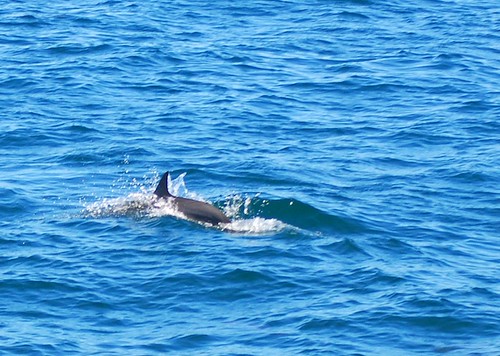
 Dolphins love to chase after fast boats and play in the wake or in the bow wave ahead of the boat. I saw them twice while we were in the Galapagos. The above dolphin was not close to the boat -- he was participating in a feeding frenzy that we saw from the Islander.
Dolphins love to chase after fast boats and play in the wake or in the bow wave ahead of the boat. I saw them twice while we were in the Galapagos. The above dolphin was not close to the boat -- he was participating in a feeding frenzy that we saw from the Islander.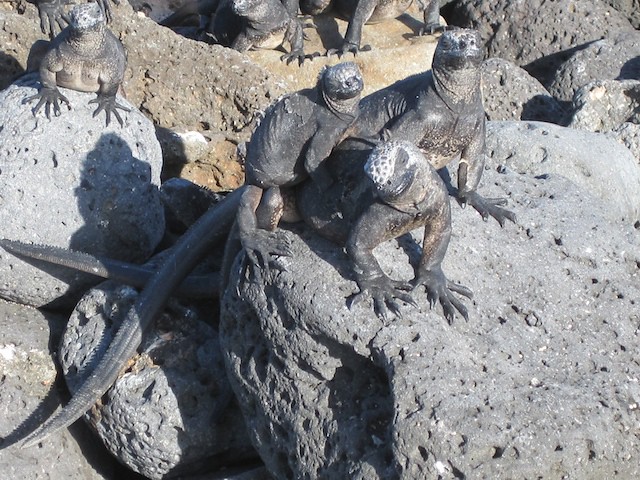
 I'm fascinated by the description of marine iguanas as "imps of darkness," a term first used in the Voyage of H. M. S. Blonde to the Sandwich Islands, in the years 1824-1825 by Captain the Right Hon. Lord Byron, Commander. During his voyage to Hawaii (the Sandwich Islands) he stopped in Galapagos, where he saw these unique creatures that are found only here.
I'm fascinated by the description of marine iguanas as "imps of darkness," a term first used in the Voyage of H. M. S. Blonde to the Sandwich Islands, in the years 1824-1825 by Captain the Right Hon. Lord Byron, Commander. During his voyage to Hawaii (the Sandwich Islands) he stopped in Galapagos, where he saw these unique creatures that are found only here.Our party to Narborough Island landed among an innumberable host of sea-guanas, the ugliest living creatures we ever beheld.
They are like the alligator, but with a more hideous head, and of a dirty sooty black colour, and sat on the black lava rocks like so many imps of darkness. As far as the eye could reach we saw nothing but rough fields of lava, that seemed to have hardened while the force of the wind had been rippling its liquid surface. In some places we could fancy the fiery sea had been only gently agitated; in others, it seemed as if it had been swept into huge waves. Here and there it was rent into deep crevices coated with iron rust, and filled up with salt water. Far inland too, the pools are salt; and not a vegetable, but the cactus here and there, is seen to root in the rock. Seaward, however, the eye is relieved by a few patches of mangrove, which have begun to fringe the desolate place with green. [Reproduced here.]
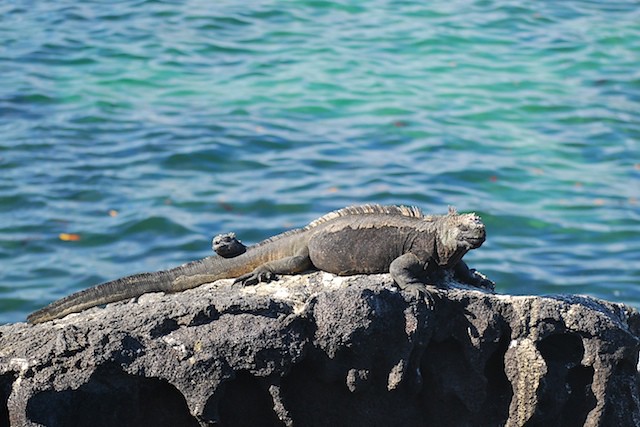

 The ocean used to be infinite -- but the oil spill in the Gulf of Mexico brings home how vulnerable the vast seas now have become. Moby Dick is about the vastness of the sea -- yet another impetus that led me to read it.
The ocean used to be infinite -- but the oil spill in the Gulf of Mexico brings home how vulnerable the vast seas now have become. Moby Dick is about the vastness of the sea -- yet another impetus that led me to read it.
Melville's sketches are fascinating. Above all, he conveys the highly negative view that the voyagers of his time mainly held. He refers to various islands with words like these: "woebegone landscape," "a dead desert rock," "grim cliffs," and "one of the most northerly of the group, so solitary, remote, and blank, it looks like No-Man's Land seen off our northern shore."Indeed, there are seasons when currents quite unaccountable prevail for a great distance round about the total group, and are so strong and irregular as to change a vessel's course against the helm, though sailing at the rate of four or five miles the hour. The difference in the reckonings of navigators produced by these causes, along with the light and variable winds, long nourished a persuasion that there existed two distinct clusters of isles in the parallel of the Encantadas, about a hundred leagues apart. Such was the idea of their earlier visitors, the Buccaneers; and as late as 1750 the charts of that part of the Pacific accorded with the strange delusion. And this apparent fleetingness and unreality of the locality of the isles was most probably one reason for the Spaniards calling them the Encantada, or Enchanted Group.
But ... the modern voyager will be inclined to fancy that the bestowal of this name might have in part originated in that air of spellbound desertness which so significantly invests the isles. Nothing can better suggest the aspect of once living things malignly crumbled from ruddiness into ashes. Apples of Sodom, after touching, seem these isles.
However wavering their place may seem by reason of the currents, they themselves, at least to one upon the shore, appear invariably the same: fixed, cast, glued into the very body of cadaverous death.
Nor would the appellation “enchanted” seem misapplied in still another sense. For concerning the peculiar reptile inhabitant of these wilds—whose presence gives the group its second Spanish name, Gallipagos—concerning the tortoises found here, most mariners have long cherished a superstition not more frightful than grotesque. They earnestly believe that all wicked sea officers, more especially commodores and captains, are at death (and in some cases before death) transformed into tortoises, thenceforth dwelling upon these hot aridities, sole solitary lords of Asphaltum.
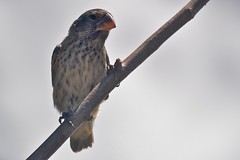

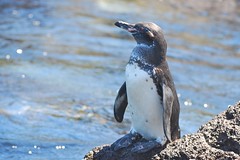 On more than one zodiac tour, penguins sat right next to the water’s edge as our boat came up for all of us photographers to snap a close-up.
On more than one zodiac tour, penguins sat right next to the water’s edge as our boat came up for all of us photographers to snap a close-up.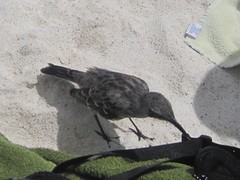 If you leave your pack on the beach near where you are sitting -- a normal thing to do -- the mockingbird will light on your pack and peer inside or will sip a drop of water from the lid of your bottle. (Incidentally, Darwin observed the differences in Galapagos mockingbird species before he got onto the finches, but that’s a long story.)
If you leave your pack on the beach near where you are sitting -- a normal thing to do -- the mockingbird will light on your pack and peer inside or will sip a drop of water from the lid of your bottle. (Incidentally, Darwin observed the differences in Galapagos mockingbird species before he got onto the finches, but that’s a long story.)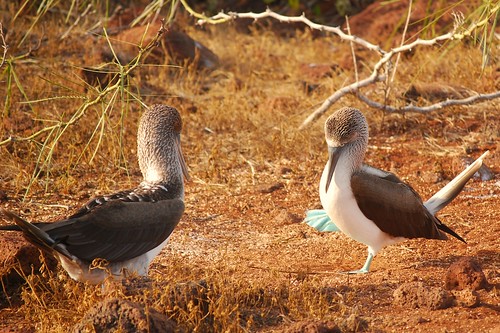

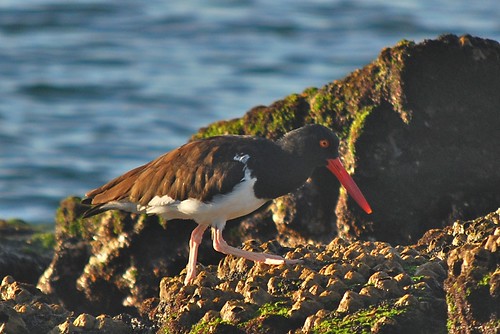




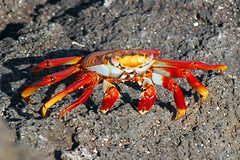
 All they do is snort salt out of the gland on their heads that allows them to drink seawater while munching on sea plants. Their scaly black and red skin, strange faces, long claws, and fringed ridge along the back make them look like the evil imps in a fairy tale. Actually, they are harmless vegetarians.
All they do is snort salt out of the gland on their heads that allows them to drink seawater while munching on sea plants. Their scaly black and red skin, strange faces, long claws, and fringed ridge along the back make them look like the evil imps in a fairy tale. Actually, they are harmless vegetarians.
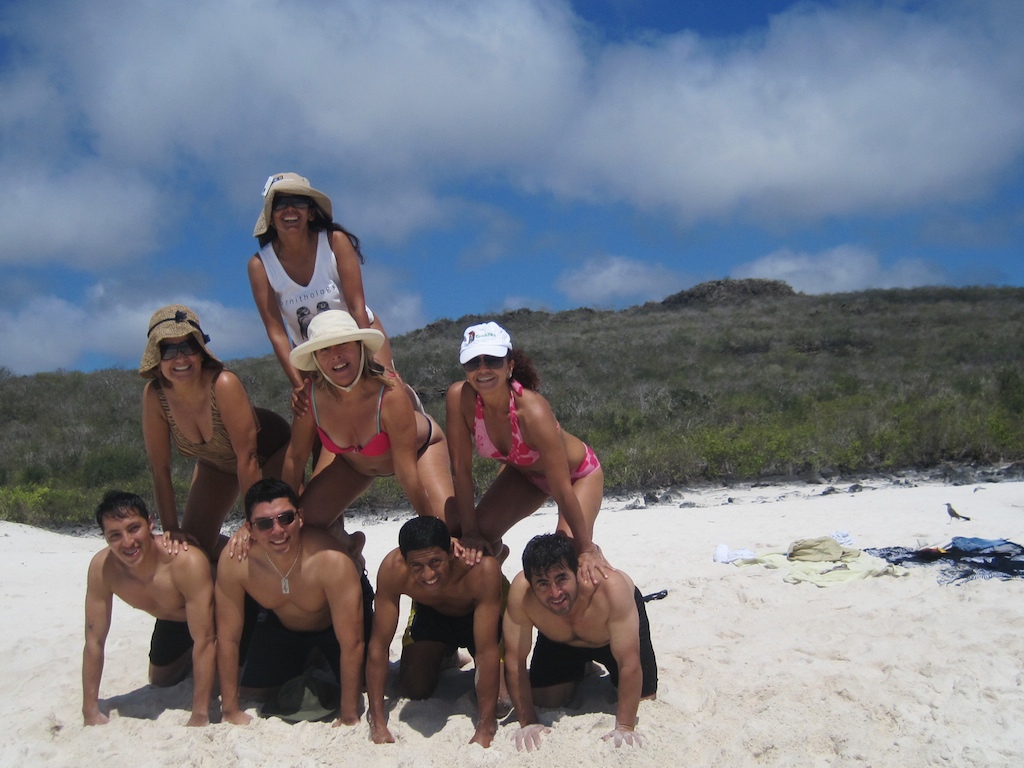

 Kitchen workers cook, bake, prepare fruit and vegetables, wait tables at dinner, stock the buffet at lunch and breakfast, tend bar, clear tables, wash dishes, and generally keep up with the three big meals and two or three snacks served each day. On the last night we discovered that they also do cute skits and the pastry chef sings Latin American songs.
Kitchen workers cook, bake, prepare fruit and vegetables, wait tables at dinner, stock the buffet at lunch and breakfast, tend bar, clear tables, wash dishes, and generally keep up with the three big meals and two or three snacks served each day. On the last night we discovered that they also do cute skits and the pastry chef sings Latin American songs. Above, when I got up to the deck around 7 AM, the sun was still behind the volcanic island on the horizon; then it appeared:
Above, when I got up to the deck around 7 AM, the sun was still behind the volcanic island on the horizon; then it appeared:
